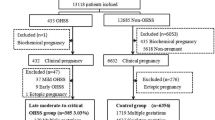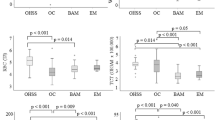Abstract
Purpose
In this study, we aimed to identify whether there are any differences in pregnancy outcomes in patients with severe ovarian hyperstimulation syndrome (OHSS) following the drainage of ascites by central venous catheter or paracentesis. We also aimed to identify differences in pregnancy outcomes between severe OHSS patients and non-OHSS IVF patients.
Methods
This was a retrospective cohort analysis carried out in a university-affiliated reproductive center between 2012 and 2019 featuring 359 women with severe OHSS following ascites draining and 345 non-OHSS women (matched by age and the number of oocytes retrieved). We investigated the rates of clinical pregnancy, multiple pregnancies, miscarriage, live birth, and preterm delivery, between the two groups. Within the OHSS group (central venous catheter group vs paracentesis group), we also analyzed the odds ratios and 95% confidence intervals of clinical pregnancy.
Results
The rate of biochemical pregnancy loss in non-OHSS patients was significantly higher than that of severe OHSS patients (11.1% vs. 0.6%; P < 0.05). Live birth rate and the rate of multiple pregnancy (twin pregnancy) were much higher in the severe OHSS group than in the non-OHSS group (88.9% vs. 73.5%; 57.6% vs. 28.1%, respectively). There was no significant difference between the rate of singleton and twin preterm delivery, and neonatal birth weight between the OHSS and the non-OHSS groups. Binary logistic regression analysis revealed that multiple pregnancy and the long superovulation protocol had high odds ratios (odds ratio (OR) = 2.53), thus suggesting that these are significant risk factors for severe OHSS. When considering the patients with severe OHSS and the manner in which they underwent ascites drainage, we found that the volume of ascites in the central venous catheter group was significantly higher than that in the abdominal paracentesis group (P < 0.05). There were no significant difference between the two groups with regards to the number of live births and the birth weight of singletons and twins (P > 0.05), although the premature birth rate of singletons in abdominal paracentesis group was 9.3% (10/107), compared with 3.75% in the central venous catheter group (P < 0.05).
Conclusion
Analysis indicated that for women undergoing in vitro fertilization embryo transfer (IVF-ET), a higher number of antral follicle count, COS long protocol, and multiple pregnancy may be risk factors for late-onset OHSS. Both paracentesis and central venous catheters are effective modalities for the management of ascites in patients with severe OHSS. Catheters represent a safe and effective way to treat patients who need to undergo repeated paracentesis.


Similar content being viewed by others
Abbreviations
- OHSS:
-
Ovarian hyperstimulation syndrome
- VEGF:
-
Vascular endothelial growth factor
- IVF:
-
In vitro fertilization
- ICSI:
-
Intracytoplasmic sperm injection
- ET:
-
Embryo transfer
- FSH:
-
Follicle-stimulating hormone
- hCG:
-
Human chorionic gonadotropin
- ORs:
-
Odds ratios
References
1.Steward, R.G., et al., Oocyte number as a predictor for ovarian hyperstimulation syndrome and live birth: an analysis of 256,381 in vitro fertilization cycles. Fertil Steril, 2014. 101(4): p. 967–73.
Mourad S, Brown J, Farquhar C (2017) Interventions for the prevention of OHSS in ART cycles: an overview of Cochrane reviews. Cochrane Database Syst Rev 1:CD012103
Practice Committee of the American Society for Reproductive Medicine. Electronic address, A.a.o. and M. Practice Committee of the American Society for Reproductive, Prevention and treatment of moderate and severe ovarian hyperstimulation syndrome: a guideline. Fertil Steril, 2016. 106(7): p. 1634–1647.
Nouri K et al (2014) Polymorphisms of VEGF and VEGF receptors are associated with the occurrence of ovarian hyperstimulation syndrome (OHSS)—a retrospective case-control study. J Ovarian Res 7:54
Lyons CA et al (1994) Early and late presentation of the ovarian hyperstimulation syndrome: two distinct entities with different risk factors. Hum Reprod 9(5):792–799
Golan A et al (1989) Ovarian hyperstimulation syndrome: an update review. Obstet Gynecol Surv 44(6):430–440
Nelson SM (2017) Prevention and management of ovarian hyperstimulation syndrome. Thromb Res 151(Suppl 1):S61–S64
Kiel J (2019) Acute ascites and abdominal pain from ovarian hyperstimulation syndrome (OHSS). Am J Emerg Med 37(4):794e5-794e6
Blumenfeld Z (2018) The ovarian hyperstimulation syndrome. Vitam Horm 107:423–451
Liu N et al (2012) Comparison of follicular fluid amphiregulin and EGF concentrations in patients undergoing IVF with different stimulation protocols. Endocrine 42(3):708–716
Youssef MA, Mourad S (2016) Volume expanders for the prevention of ovarian hyperstimulation syndrome. Cochrane Database Syst Rev 8:CD001302
Raziel A et al (2002) Increased early pregnancy loss in IVF patients with severe ovarian hyperstimulation syndrome. Hum Reprod 17(1):107–110
Luke B et al (2010) Factors associated with ovarian hyperstimulation syndrome (OHSS) and its effect on assisted reproductive technology (ART) treatment and outcome. Fertil Steril 94(4):1399–1404
Choux C et al (2017) Severe ovarian hyperstimulation syndrome modifies early maternal serum beta-human chorionic gonadotropin kinetics, but obstetrical and neonatal outcomes are not impacted. Fertil Steril 108(4):650–658
Abuzeid MI et al (2003) Pigtail catheter for the treatment of ascites associated with ovarian hyperstimulation syndrome. Hum Reprod 18(2):370–373
Abuzeid M et al (2014) Outpatient management of severe ovarian hyperstimulation syndrome (OHSS) with Placement of pigtail catheter. Facts Views Vis Obgyn 6(1):31–37
Caglar Aytac P et al (2017) Effect of pigtail catheter application on obstetric outcomes in in vitro fertilization/intracytoplasmic sperm injection pregnancies following hyperstimulation syndrome. Turk J Obstet Gynecol 14(2):94–99
Author information
Authors and Affiliations
Contributions
RL designed the research and revised the manuscript; YR analyzed the data and wrote the article; RY, SY, and DS collected the data. All the authors read and approved the final manuscript.
Corresponding author
Ethics declarations
Conflict of interest
The authors declare no competing interests.
Ethics approval
Ethics approval and consent to participate: This study procedure and protocol were approved by the ethics committee of Peking University Third Hospital, Peking University, and was performed in accordance with the Declaration of Helsinki.
Additional information
Publisher's Note
Springer Nature remains neutral with regard to jurisdictional claims in published maps and institutional affiliations.
Rights and permissions
About this article
Cite this article
Ren, Y., Li, R., Yang, S. et al. Pregnancy outcomes in patients with late-onset severe OHSS following different methods of ascetic fluid drainage and a comparison with non-OHSS IVF patients. Arch Gynecol Obstet 305, 1587–1594 (2022). https://doi.org/10.1007/s00404-021-06326-x
Received:
Accepted:
Published:
Issue Date:
DOI: https://doi.org/10.1007/s00404-021-06326-x




